Access to the World of Cinema
On Chantal Akerman’s Entrance Exam to INSAS

Asked about his favourite films of 2023, Pedro Costa’s answer was clear and concise: “Nothing moved me more than the four four-minute films that Chantal Akerman shot in 1967 – a year before Saute ma ville [1968] – as her application to the INSAS in Brussels.”1 Akerman’s actual debut, only recently rediscovered, thus consists of four short films, shot on 8 mm, silent and in black-and-white, in 1967 in Brussels and Knokke. Yet it’s more than the mere discovery of the earliest work of a celebrated filmmaker that makes the findings in question so poignant.
There’s a tendency to rather conveniently discern the announcement of an entire body of work in an artist’s initial achievements, motifs that can programmatically structure an entire repertoire, thereby suppressing the pieces’ inherent quality. It’s equally tempting to look at these short films with this preconceived view. Akerman films Brussels and its inhabitants, a friend doing the dishes, her mother in a shoe shop, herself posing in front of a convertible; everyday scenes observed as well as staged, with protagonists and actions that will come to play a crucial role in her work until the end of her career. More impressive, however, is the discovery of exactly what she wanted to make and submit as a seventeen-year-old aspiring filmmaker for the entrance exam of a film school in the late 1960s. The story is well known: It was Jean-Luc Godard’s Pierrot le fou that drove Akerman, in 1965 at the age of fifteen, to try her hand at cinema. Without this epiphany, the discovery of a cinema unbound, she would most probably have become a writer, she claims herself.
If one wants to make films, to become a filmmaker, one usually applies to a film school. Even today, access to the world of cinema proceeds mainly through the institution in question. To enrol, applicants must first pass an entrance exam. As non-filmmakers, they must first prove they are already something of a filmmaker, with something to offer. In the late 1960s, making a short film was part of INSAS’ entrance exam. Akerman made two short films in Brussels and two at the seaside town of Knokke. The first film is a short impression of the annual Midi Fair in Brussels. She films the movements and lights of the attractions, observes people standing in front of stalls, eating snacks and having fun. The second Brussels clip shows Marilyn Watelet, the childhood friend with whom she later founded the production company Paradise Films in the 1970s, Marilyn’s sister Claudine and their mother Nicole. Remarkably, the first footage is set in the former Clèves-Ravenstein house, located near the film museum of the Royal Belgian Film Archive, now known as CINEMATEK. It is also here that, fifty years later, the Chantal Akerman Foundation would be founded. Later, we see Marilyn and Claudine strolling down the street, stopping at a newsstand, doing the dishes, adorning their hair. The first clip in Knokke shows Marilyn looking at the window of a shoe shop. Shortly afterwards, we find her back in a clothing store, looking at some clothes and trying on a hat. The scene is clearly staged, Marilyn occasionally lunging uncomfortably at the camera, she sets up for the shot and repeats her actions, as if asked to perform several takes. The second Knokke shot starts with a series of parked sports cars, including a scene where we see Akerman herself posing next to one of the cars. Then we return to Marilyn standing in front of a shop window. In the shop, she peers at shoes, then Akerman’s mother, Natalia, comes into view. On a bench in the shop, she tries on pairs of shoes. Then Marilyn again, also trying on shoes and looking at herself in the mirror. Then she inspects a series of handbags; we see a saleswoman looking at Marilyn and Natalia, and the clip ends with Marilyn walking past Natalia after a direction note.
Is it already clear from these short films what type of filmmaker Chantal Akerman would become? Perhaps not. The four films are small exercises, they “tell” us nothing, they’re not really about anything. What the films mainly reveal is a determinate pleasure in filmmaking, in the art of looking, and in the making and organising of images. For her entry exam, Akerman did not adhere to any particular idea of cinema but simply pursued a very personal fascination. She displays no sought-after skill or false, lofty ambition, no implicit desire to make grand, weighty cinema. At no point does she hint at any particular content. What we see is a filmmaker playing, taking pleasure in the act of staging, just like children diving into a box of costumes and constructing short, fleeting, inconsistent fiction pieces that spawn a reality all their own. Play is at once form and content.
“You should only do what you really feel like doing,” Akerman once told friend and colleague Eric de Kuyper.2 A seemingly banal command but paradoxically an almost impossible task as a young director. Yet, De Kuyper notes, “It’s that simple with her; and also that complicated. For making such radical choices presupposes incredible courage – in a profession that already demands a lot of this virtue – the courage of despair.” Cinema is indeed the art form most governed by rules and regulations. Akerman was allowed to start at INSAS but it was not an unqualified success. After a few months, she quit. “Nobody took me seriously at that school,” she later said of her time spent at the institution. “They just laughed at me. I realised that I had to make a film to earn any respect at all. So I went to work for a bank, just long enough to finance a short film, which I shot when I was eighteen.”3 Very soon she realised that film school would not allow her to do what she really felt like doing. Her first full-fledged short film, Saute ma ville, is the result of that rebellion. From its opening minute, the film shows resistance to a prescribed form of cinema. The opening panel “Recit,” accompanied by a humming Akerman, makes it immediately ironically clear that the viewer should not expect a classic narrative. What follows is something radically simple: she locks herself in a kitchen, cooks, eats, appears to be cleaning but ultimately creates a total mess that will culminate in the gas explosion to which the film’s title refers.
“If you make films, you should never do something you don’t really enjoy doing, that doesn’t really concern you,” De Kuyper further agrees. “But that which concerns you is sometimes so hidden, sometimes so intimate and therefore also futile and trivial, that you hardly dare admit it to yourself, let alone make films about it.” Unlike what is too often taught in film schools, cinema does not have to be about visionary mastery or abstract virtuosity. That’s what makes these very first films so poignant. They contain a seed of a conviction that cinema does not require grandiose ideas, that film can be something very simple, if one finds the courage to get to know and trust one’s own means. What is moving is Akerman’s fascination with filmmaking itself and how she gives very everyday elements their place in that world of images. Looking back at the personal oeuvre she carved out over five decades, these short films testify to the perseverance Akerman showed in creating her access to the world of cinema all by herself.

- 1Pedro Emilio Segura Bernal, “Best of 2023: 35 Directors Pick Their Favorite Films of The Year, ” Films in Frame, 20 December 2023.
- 2Eric de Kuyper, “Leren leven, het leven leren. Een inleiding op Chantal Akerman,” Sabzian, 20 January 2016. Originally published in Versus 1 (1983).
- 3Interview with Alain Riou, Nouvel Observateur, 28 September 1989.
Image from Examen d’entrée INSAS – Chantal Akerman – 1967 – Knokke, Bruxelles (Chantal Akerman, 1967)
Courtesy of the Chantal Akerman Foundation

